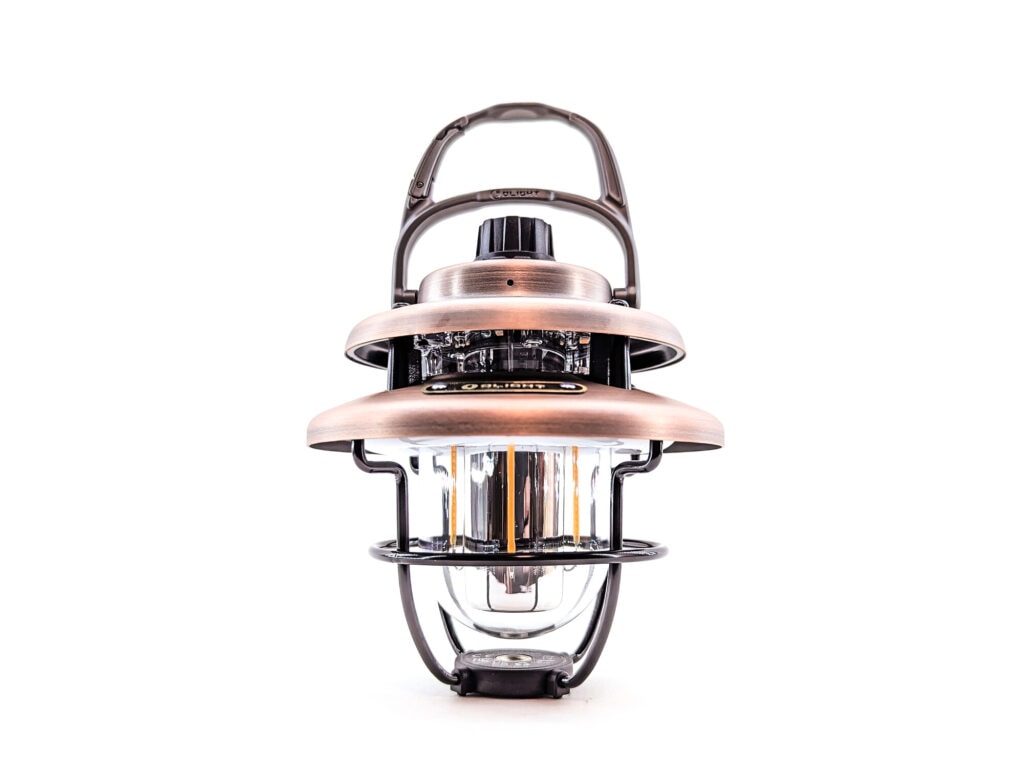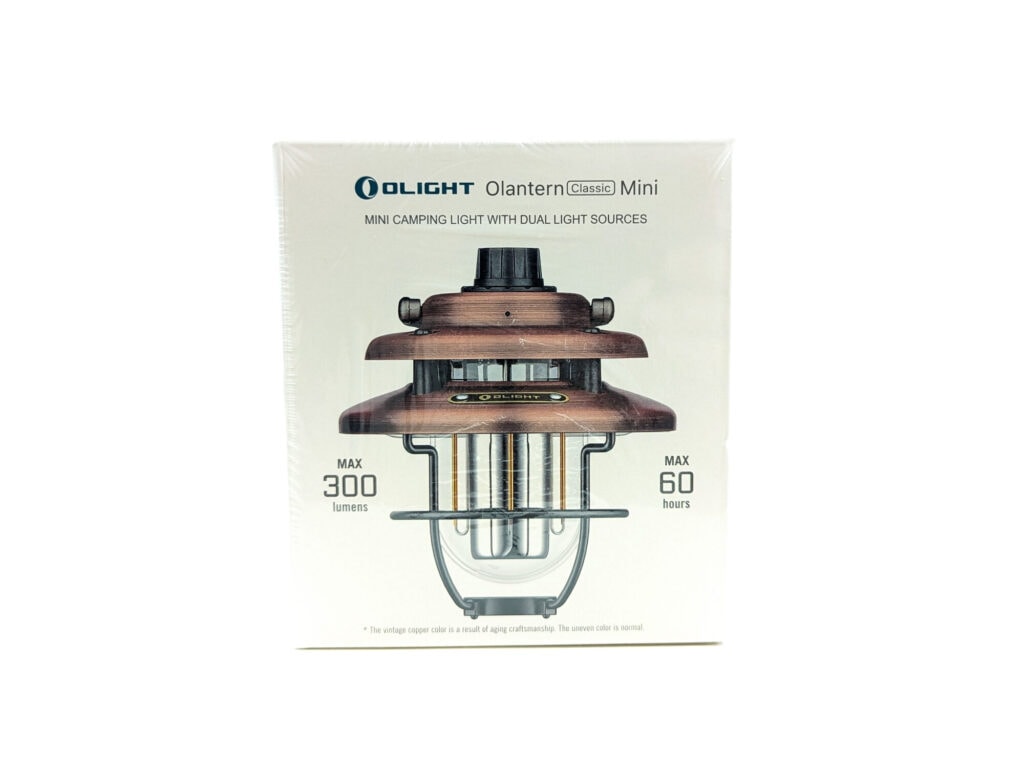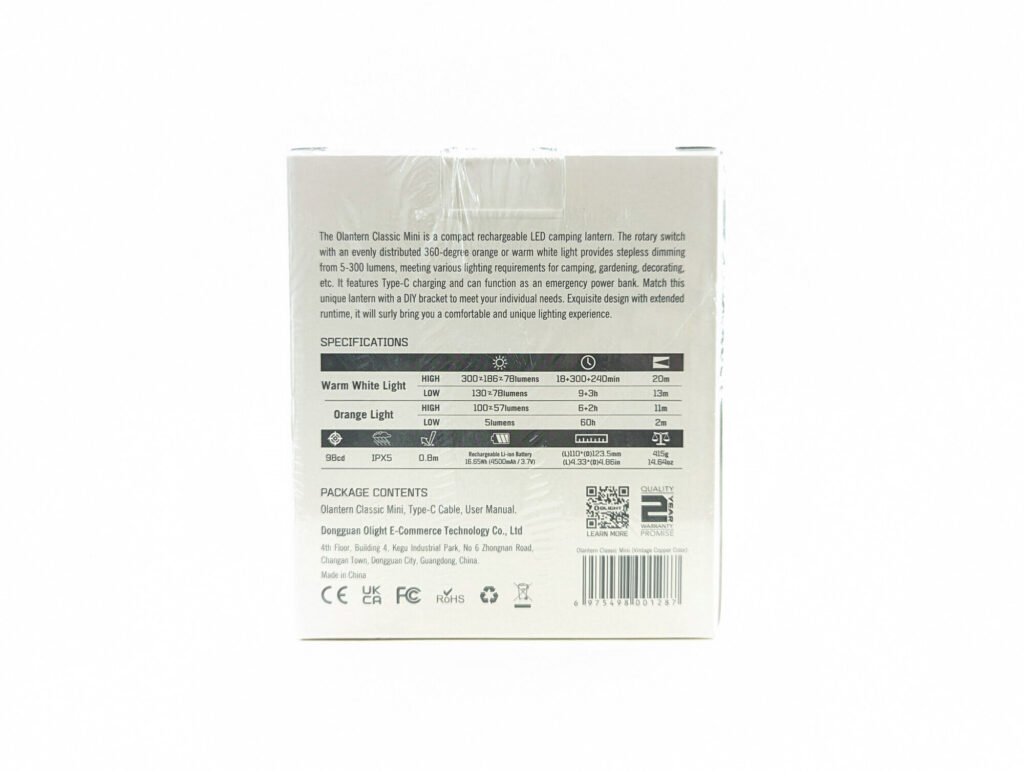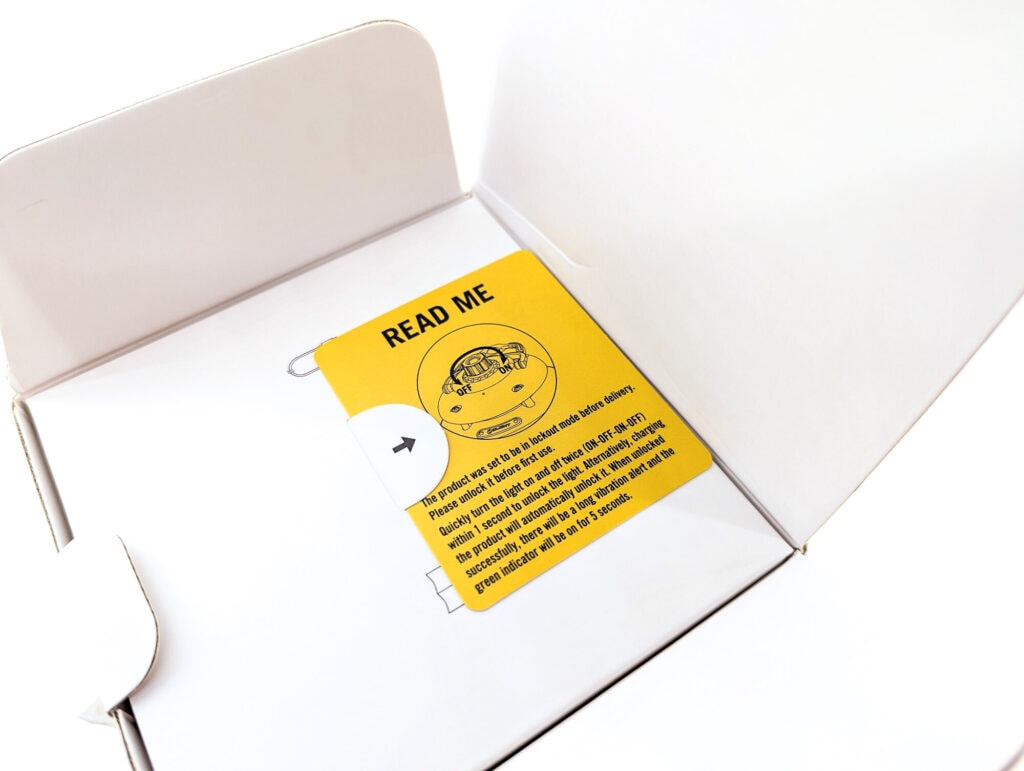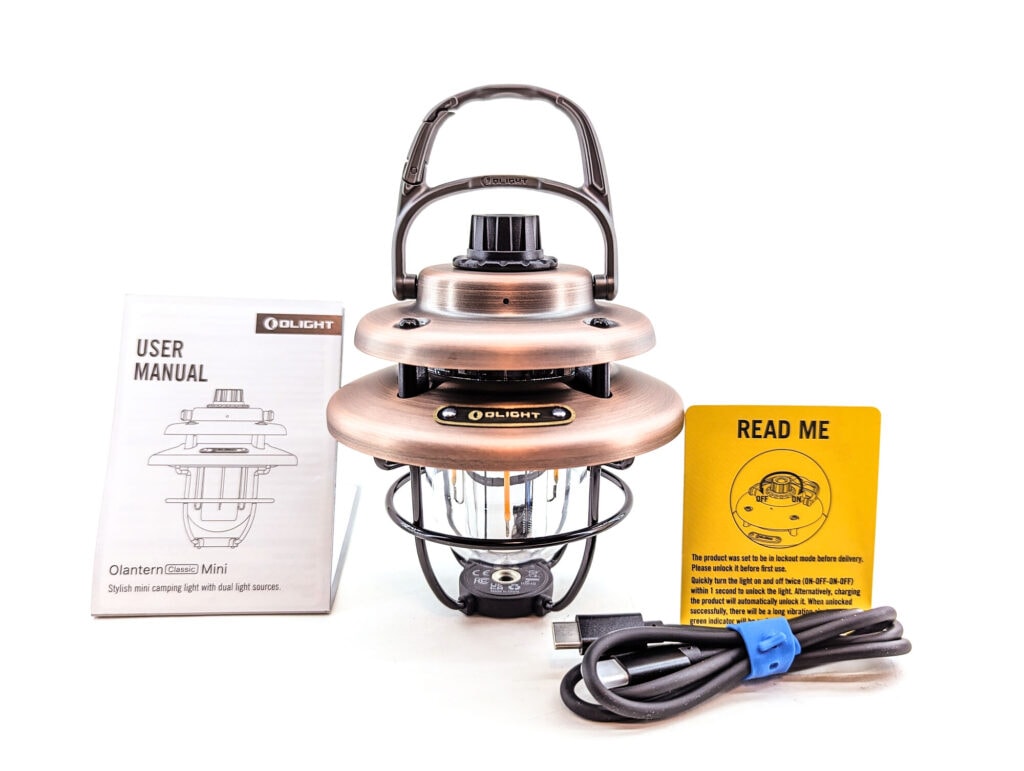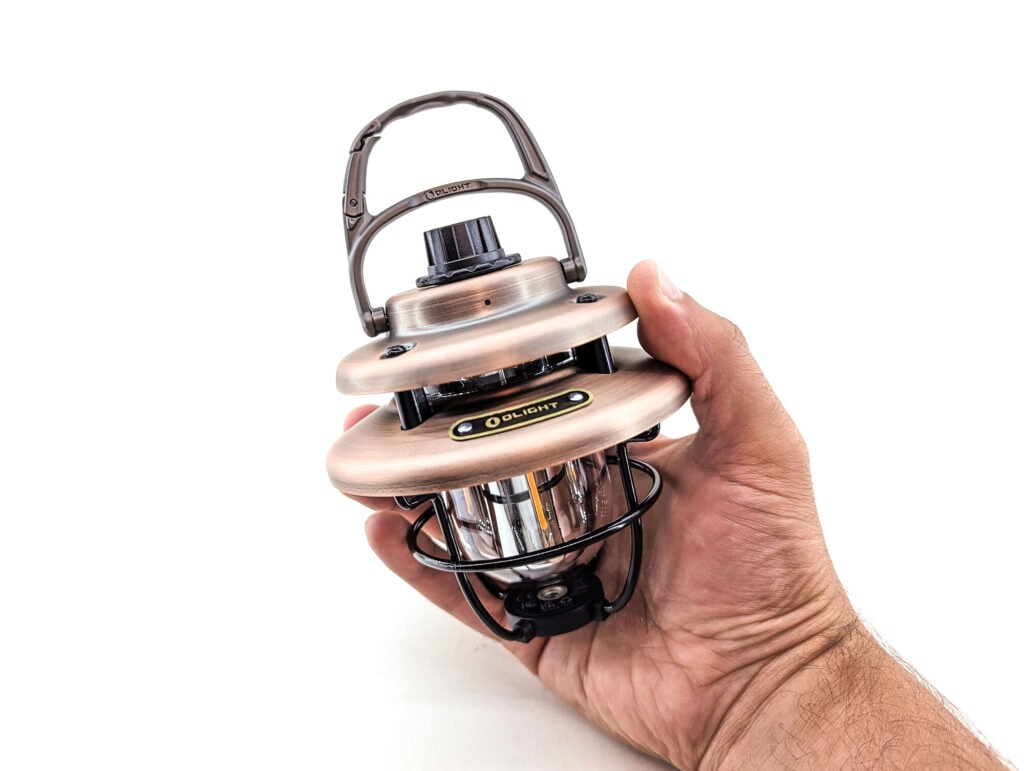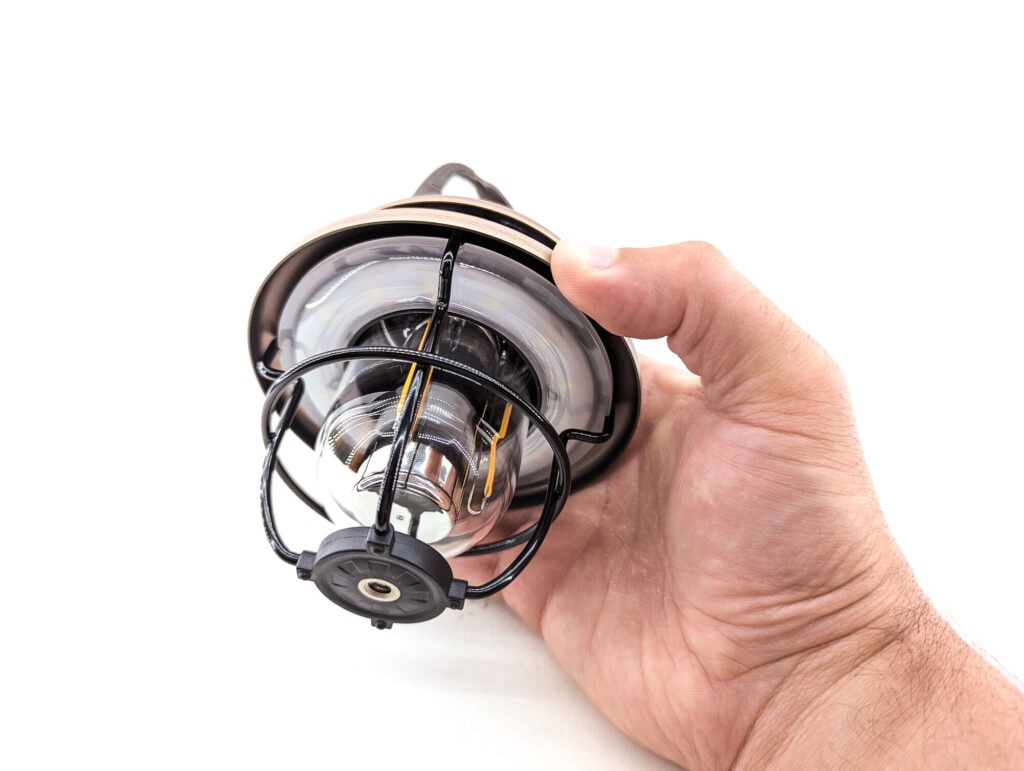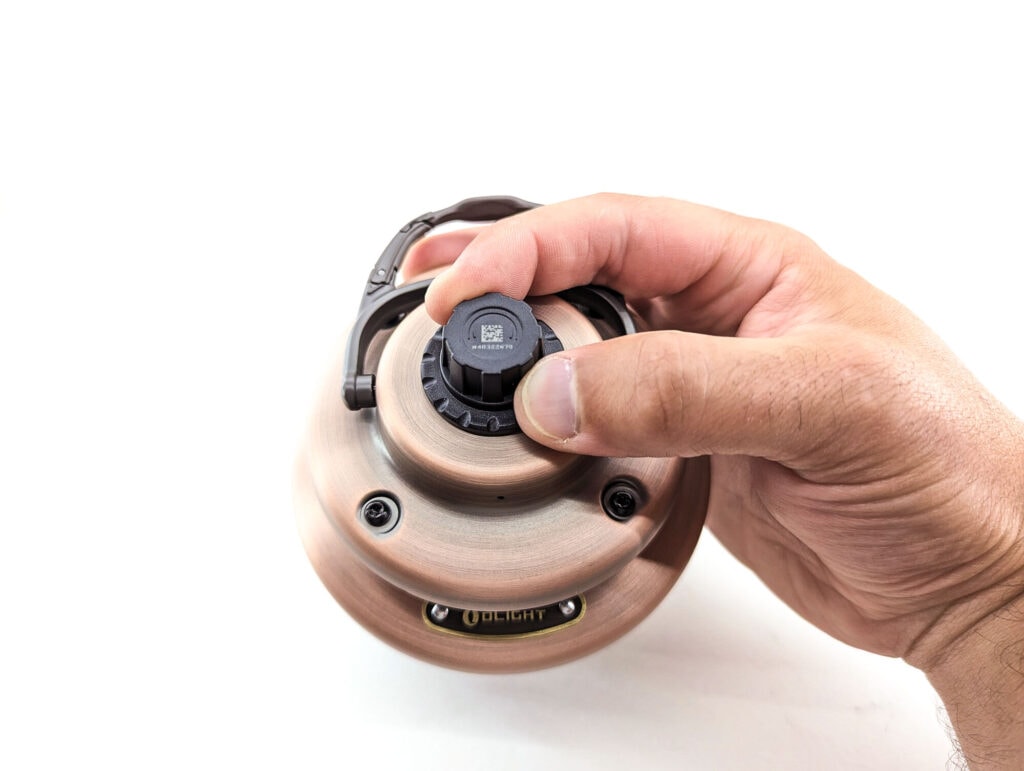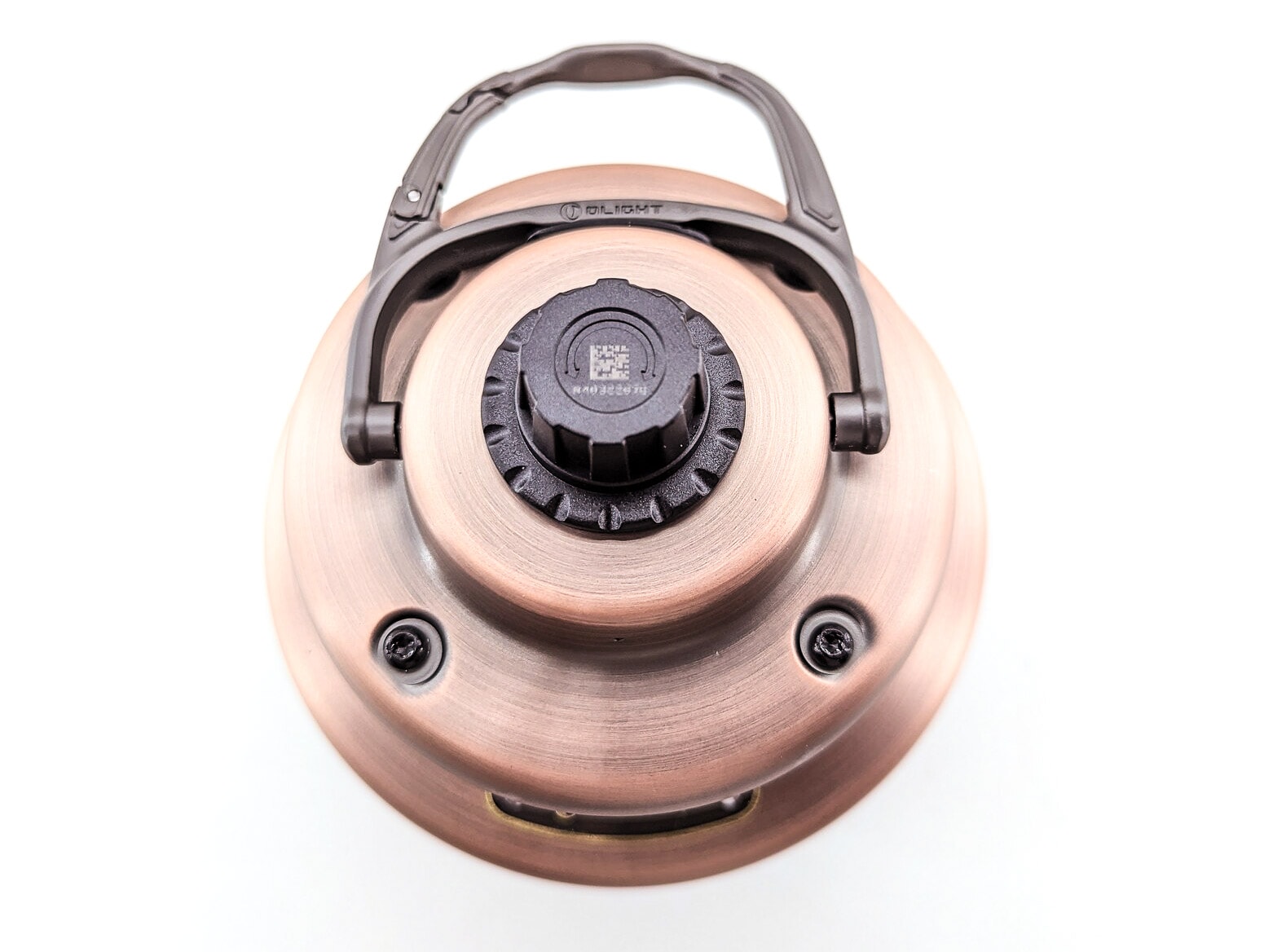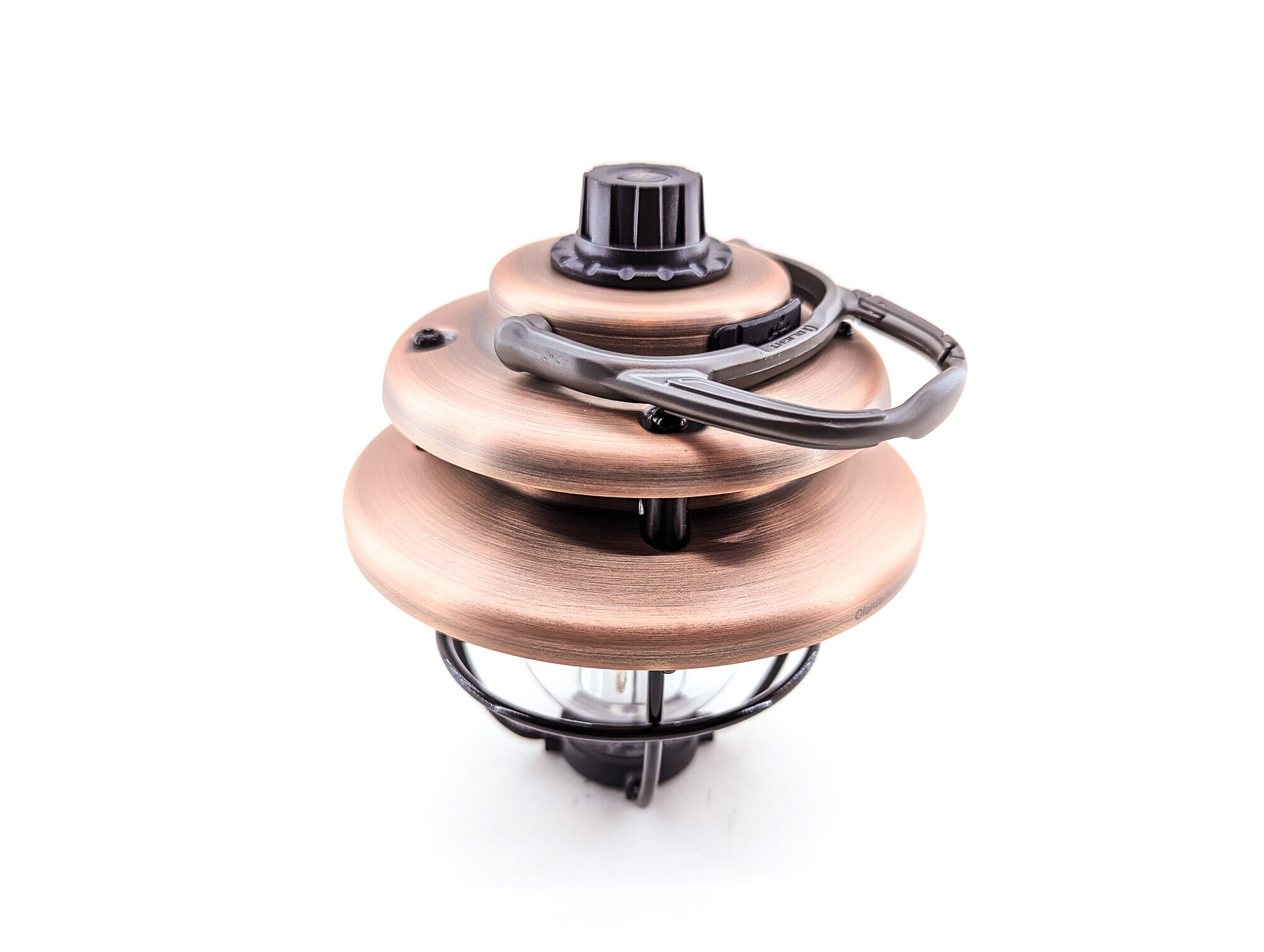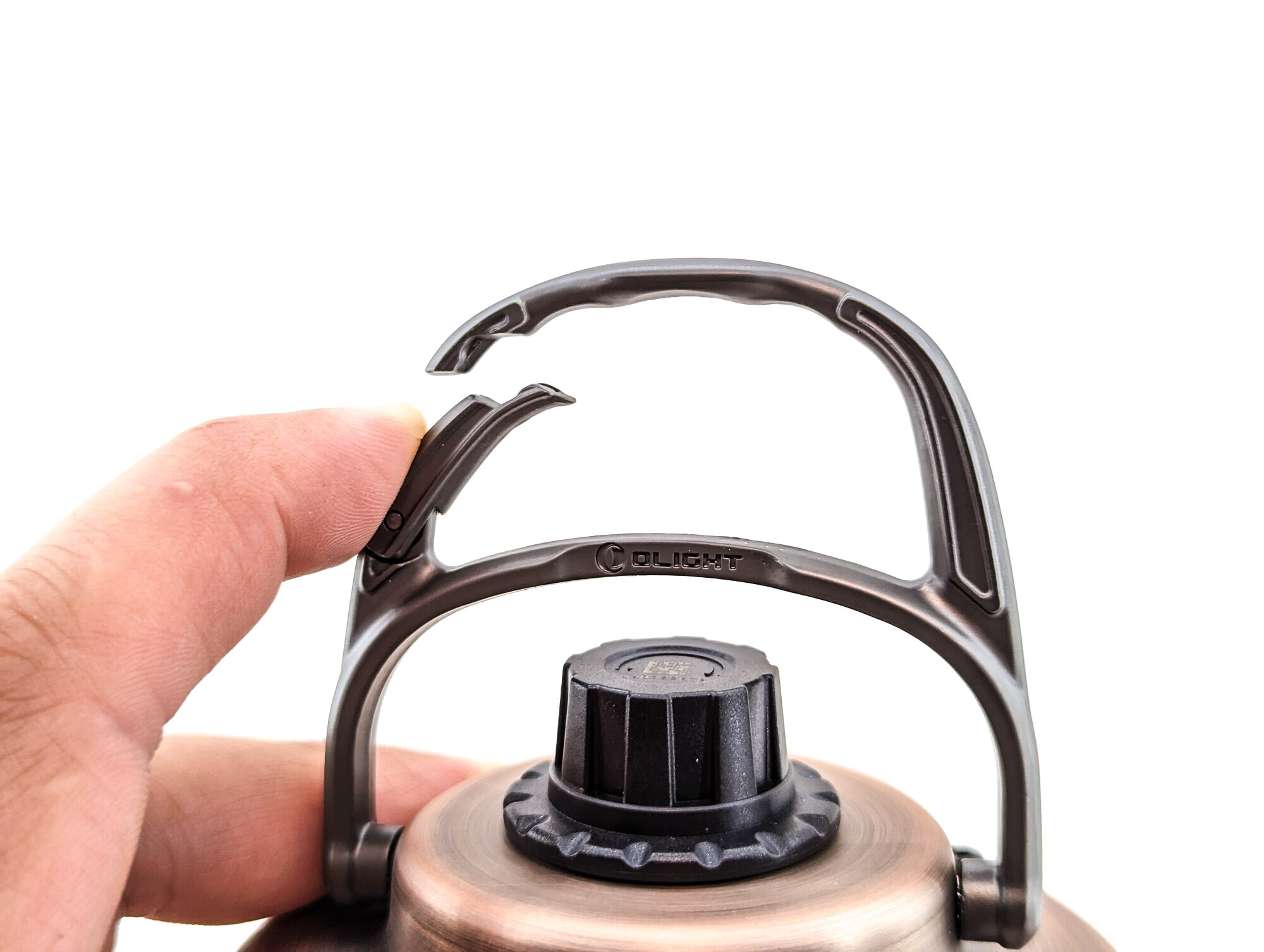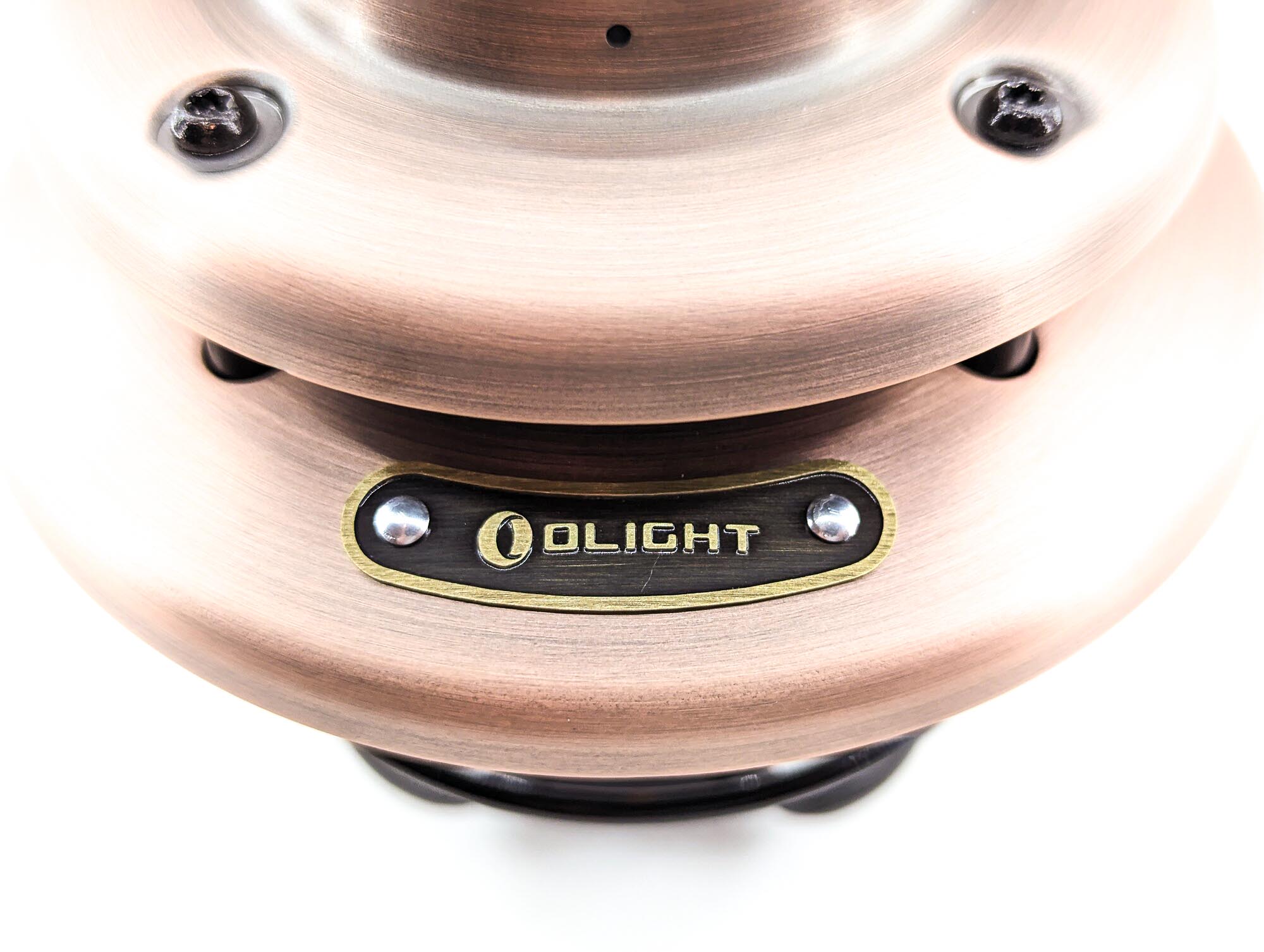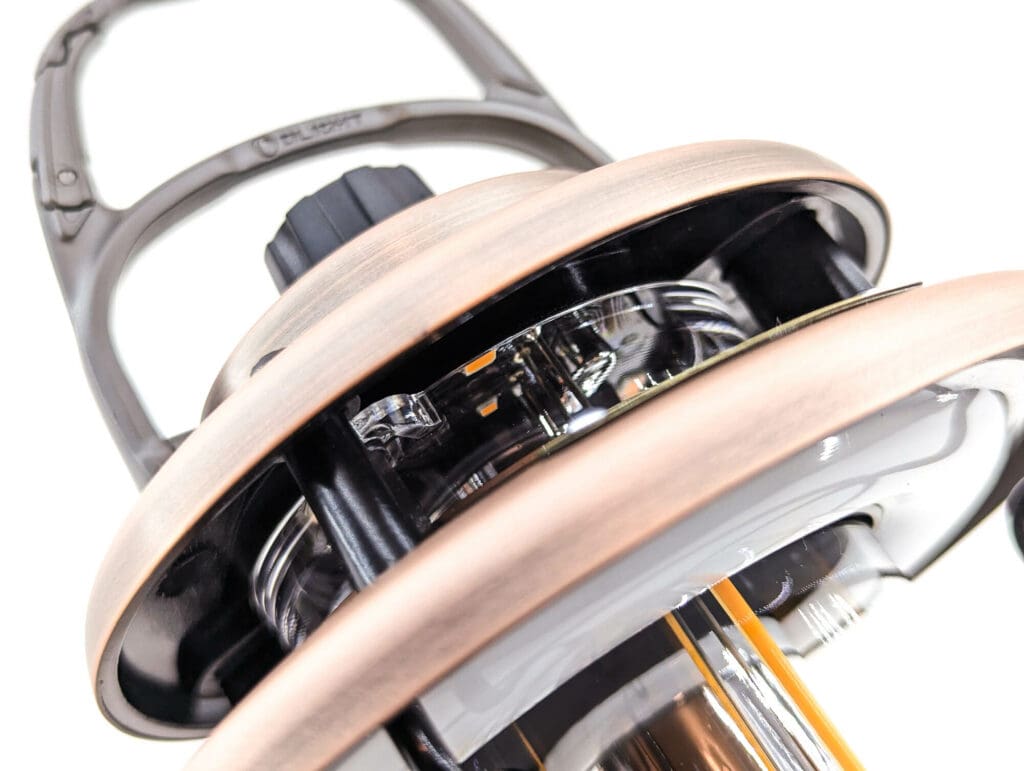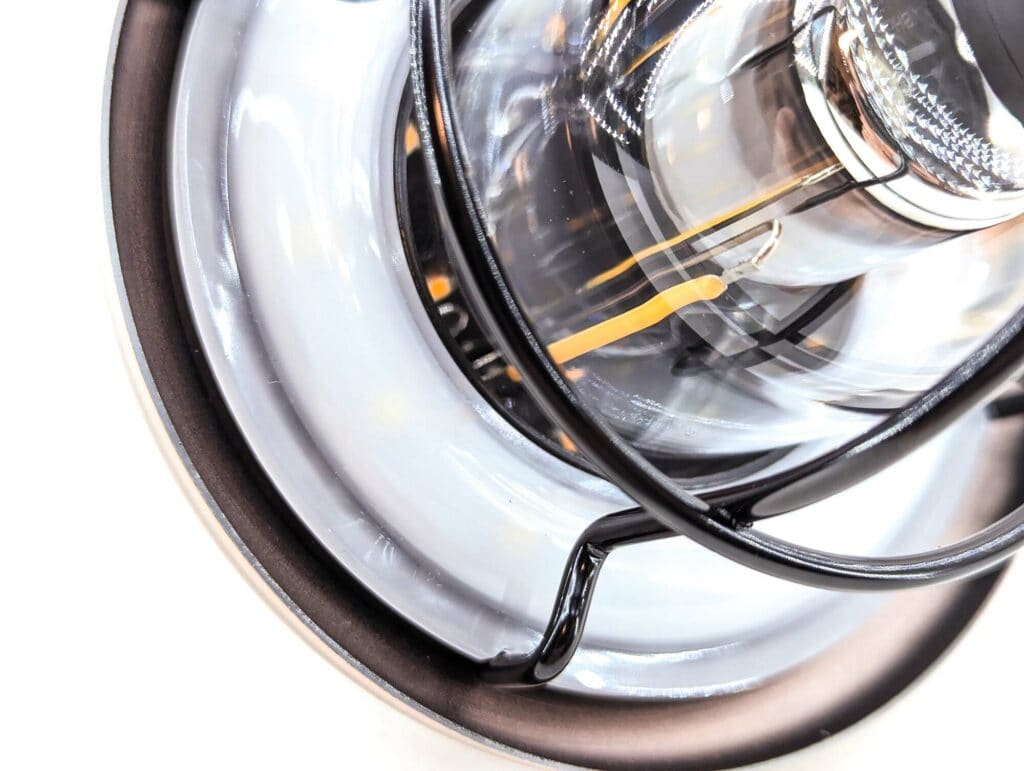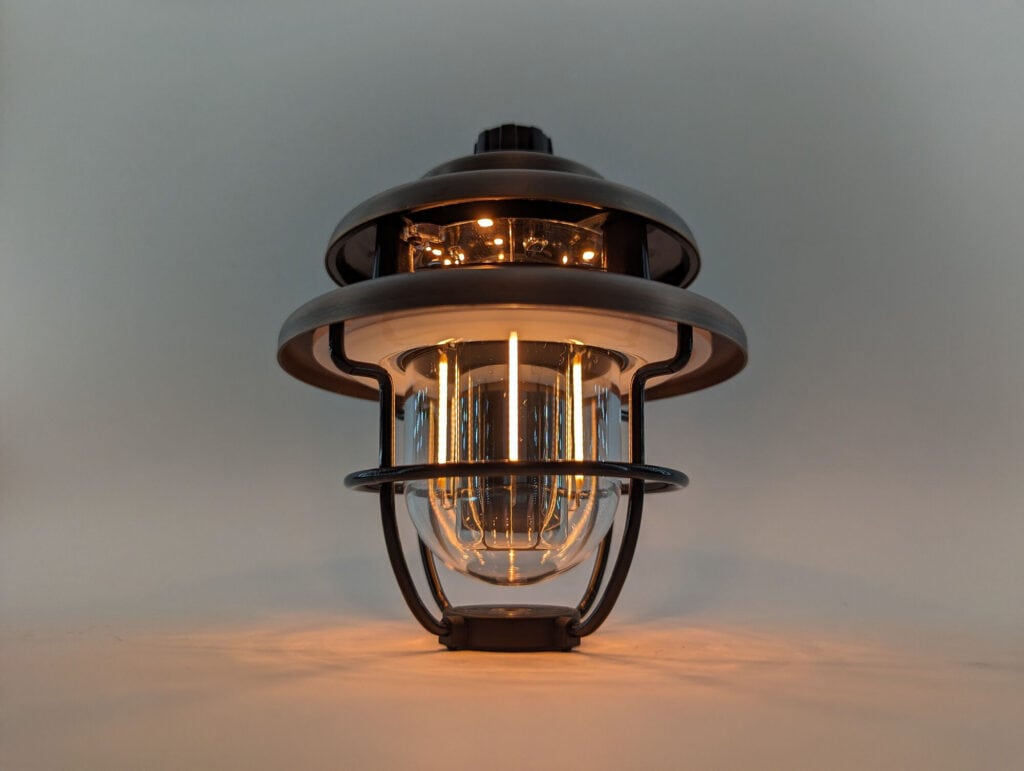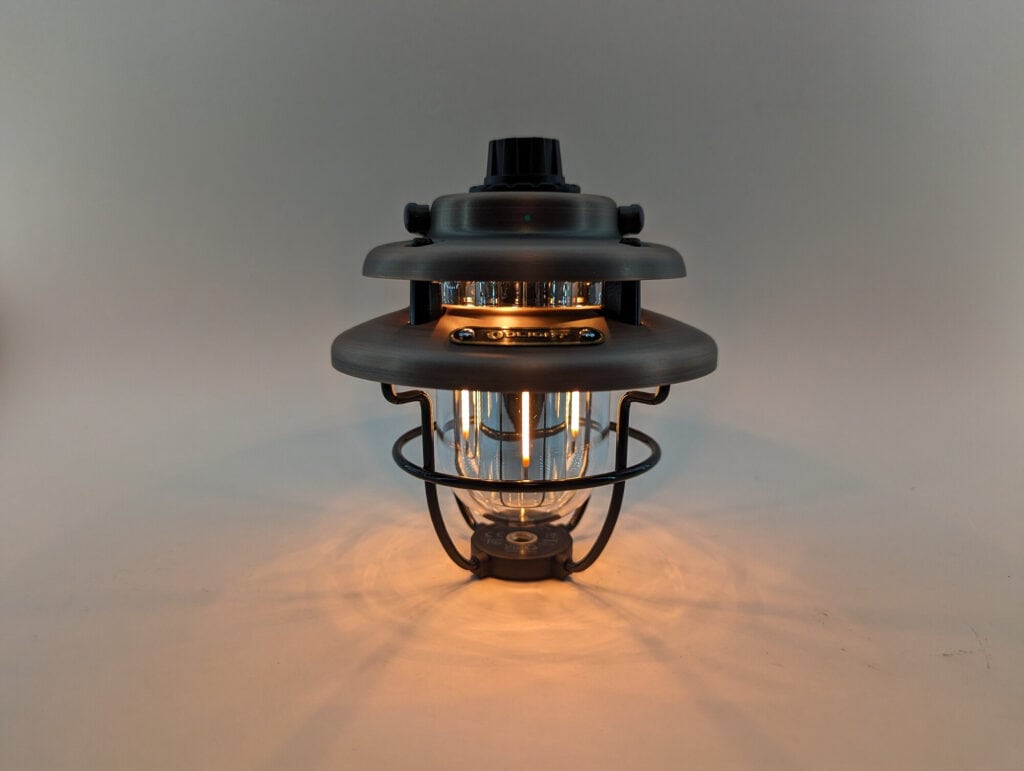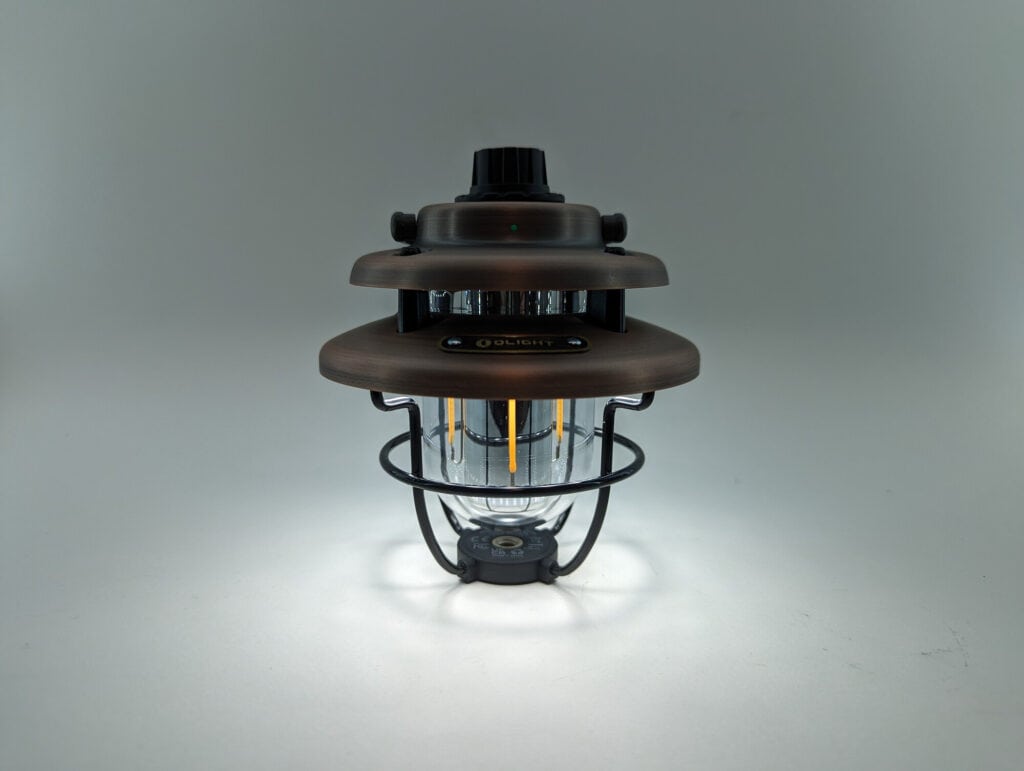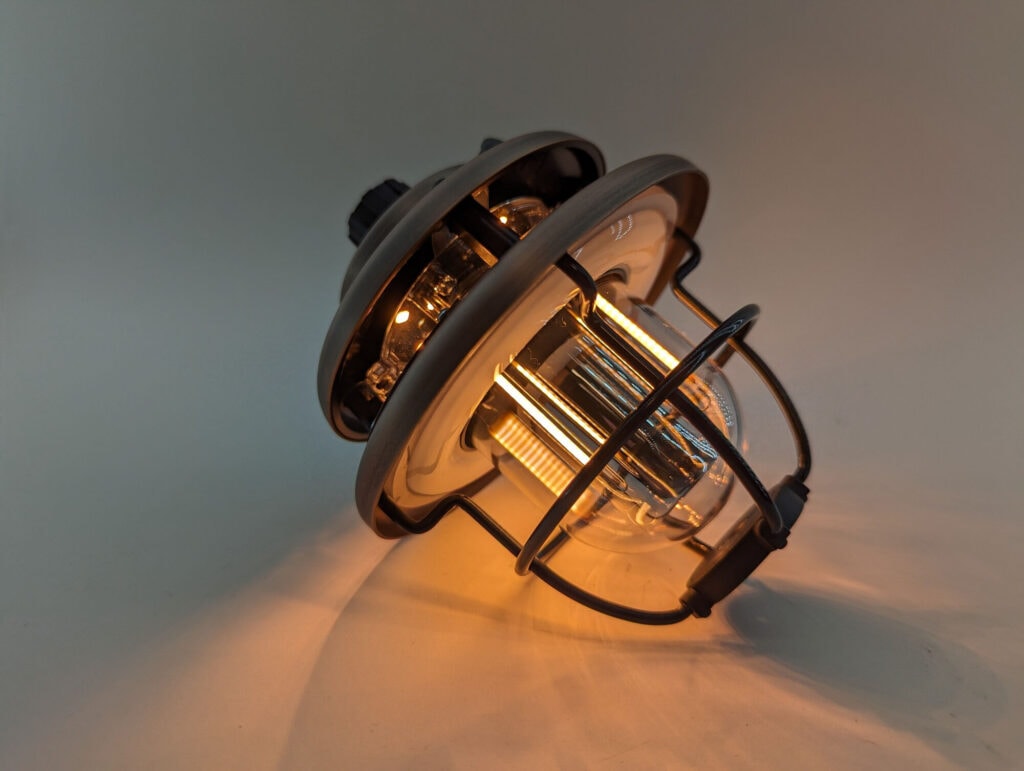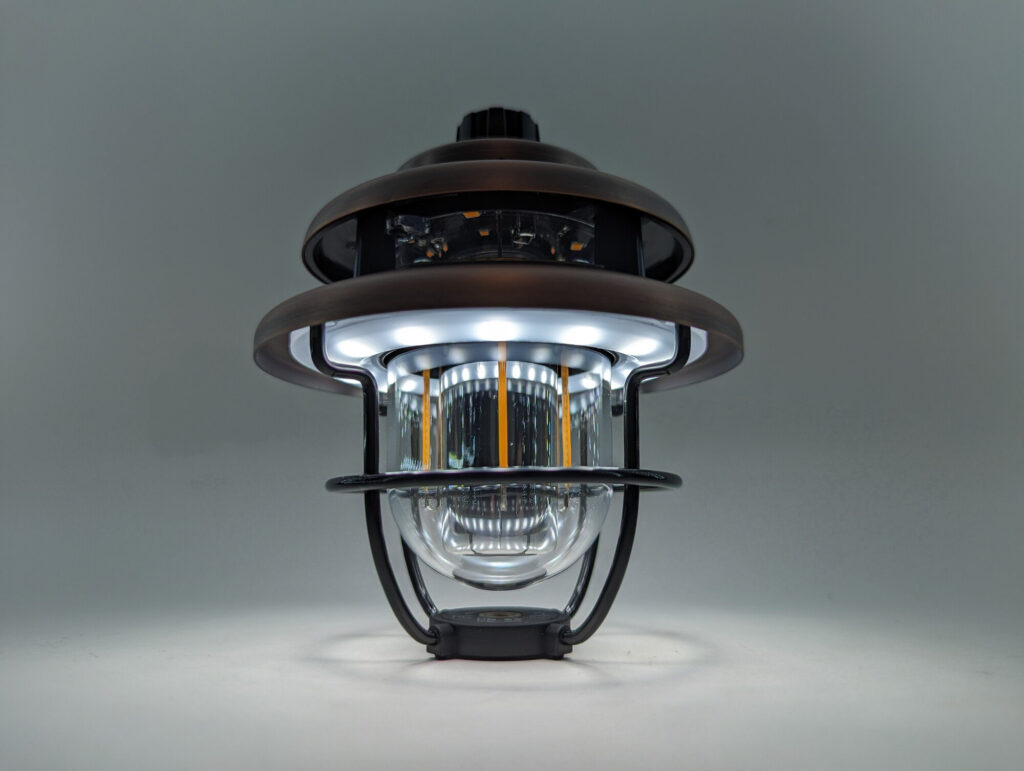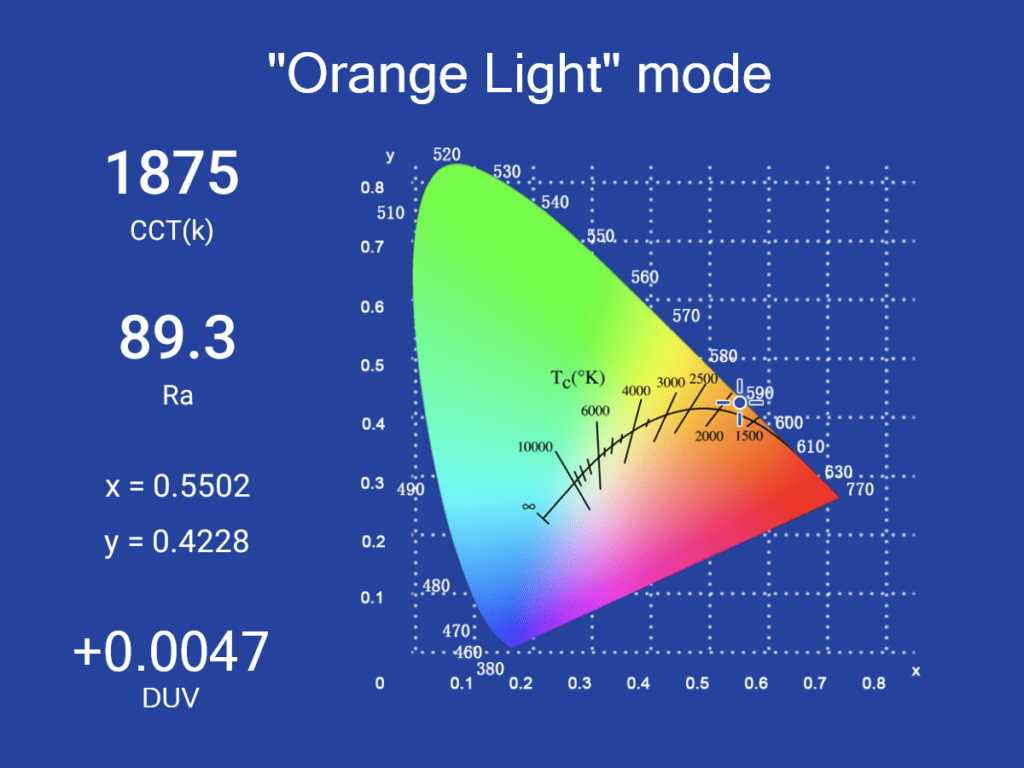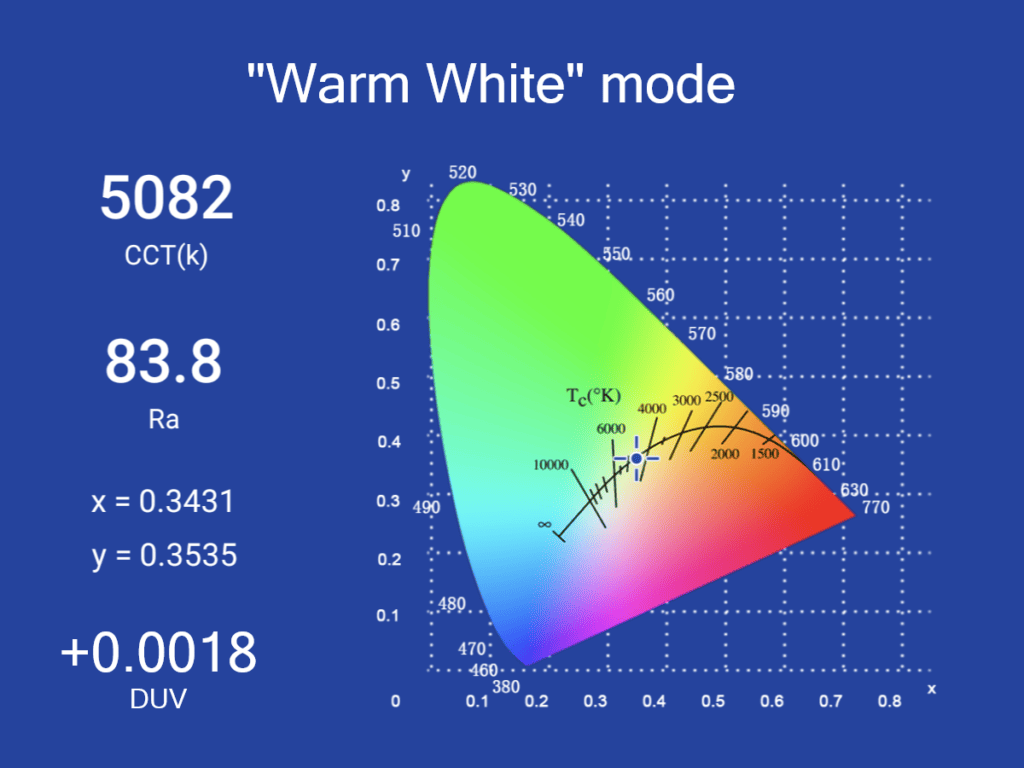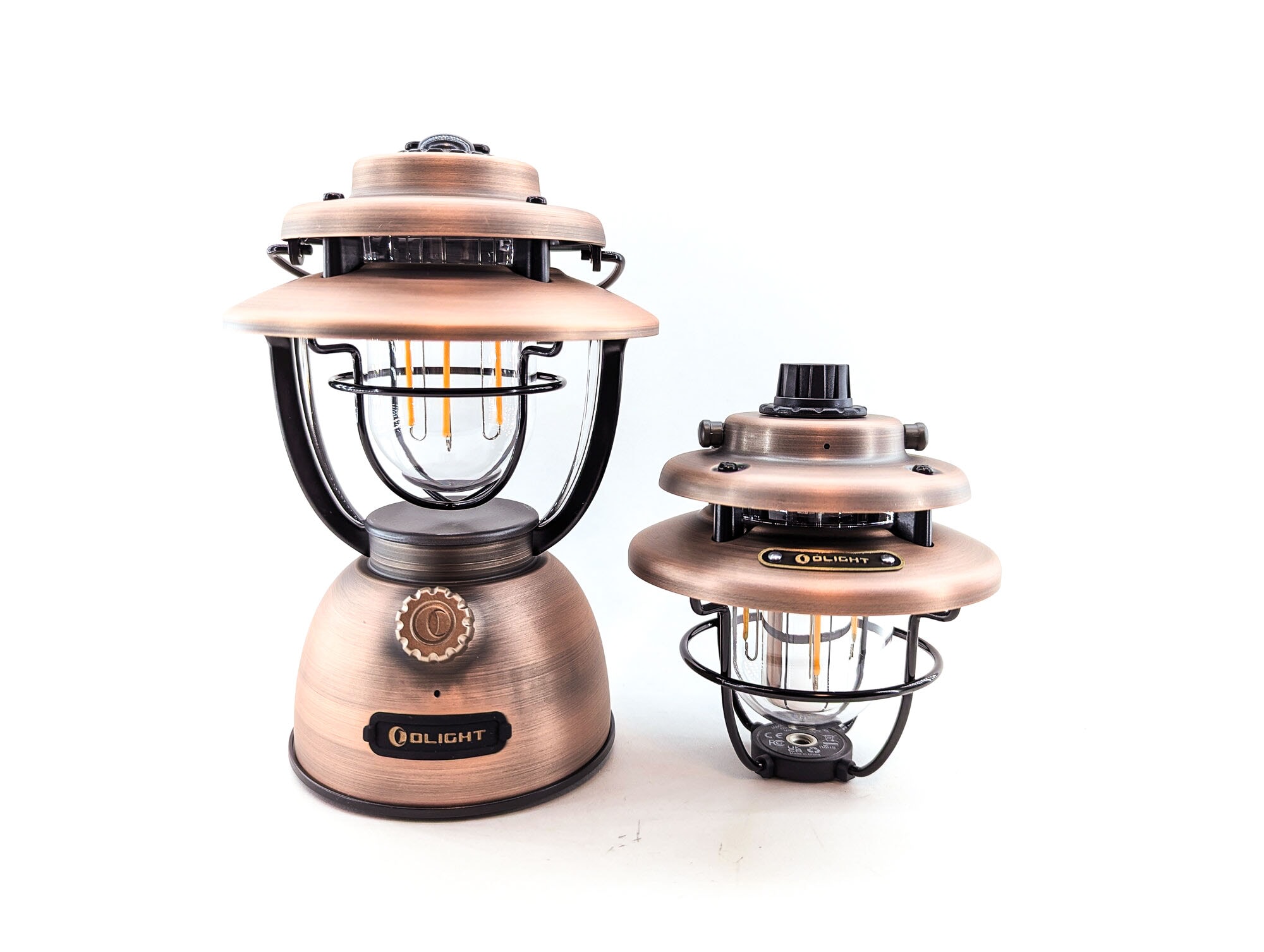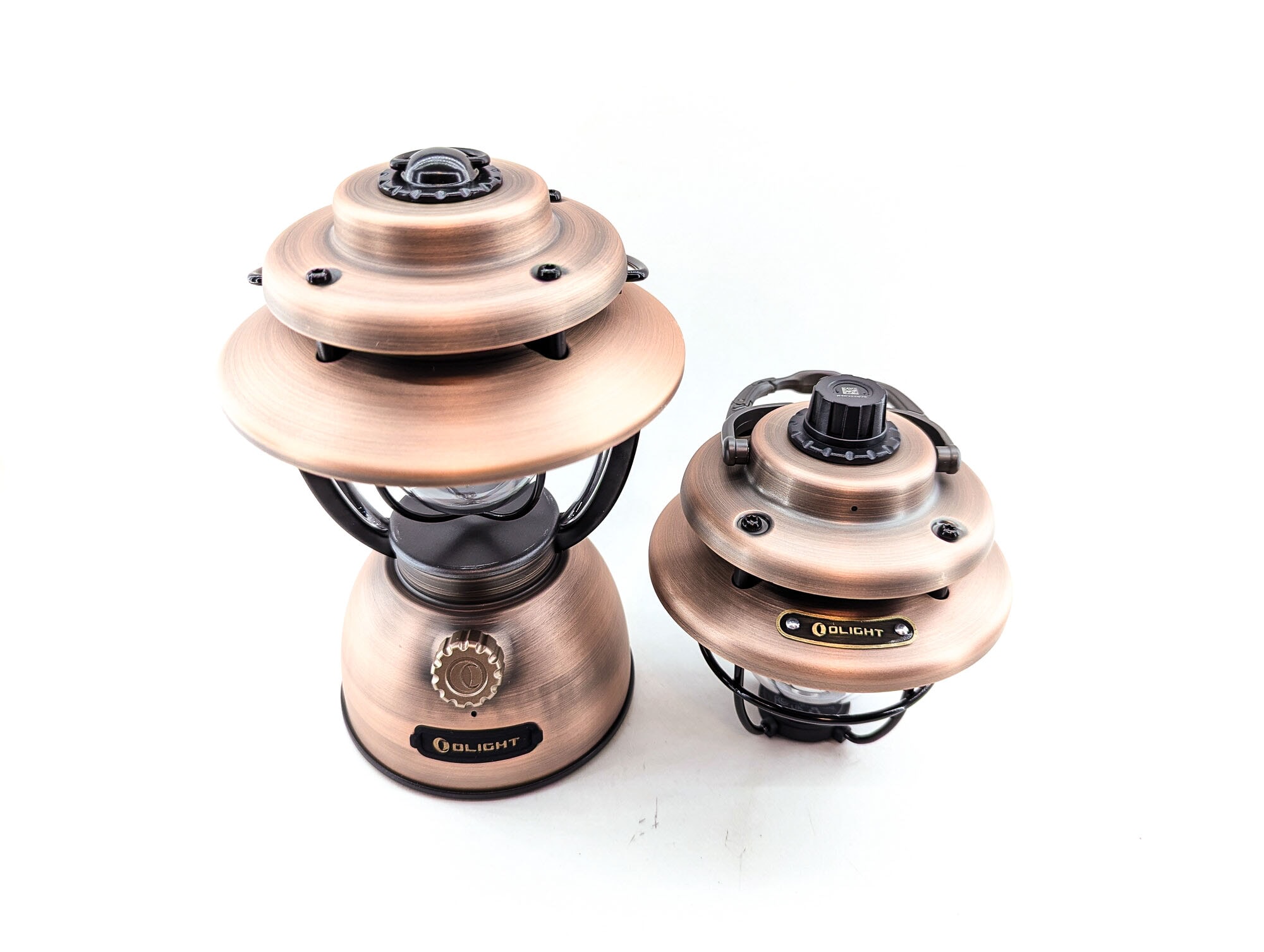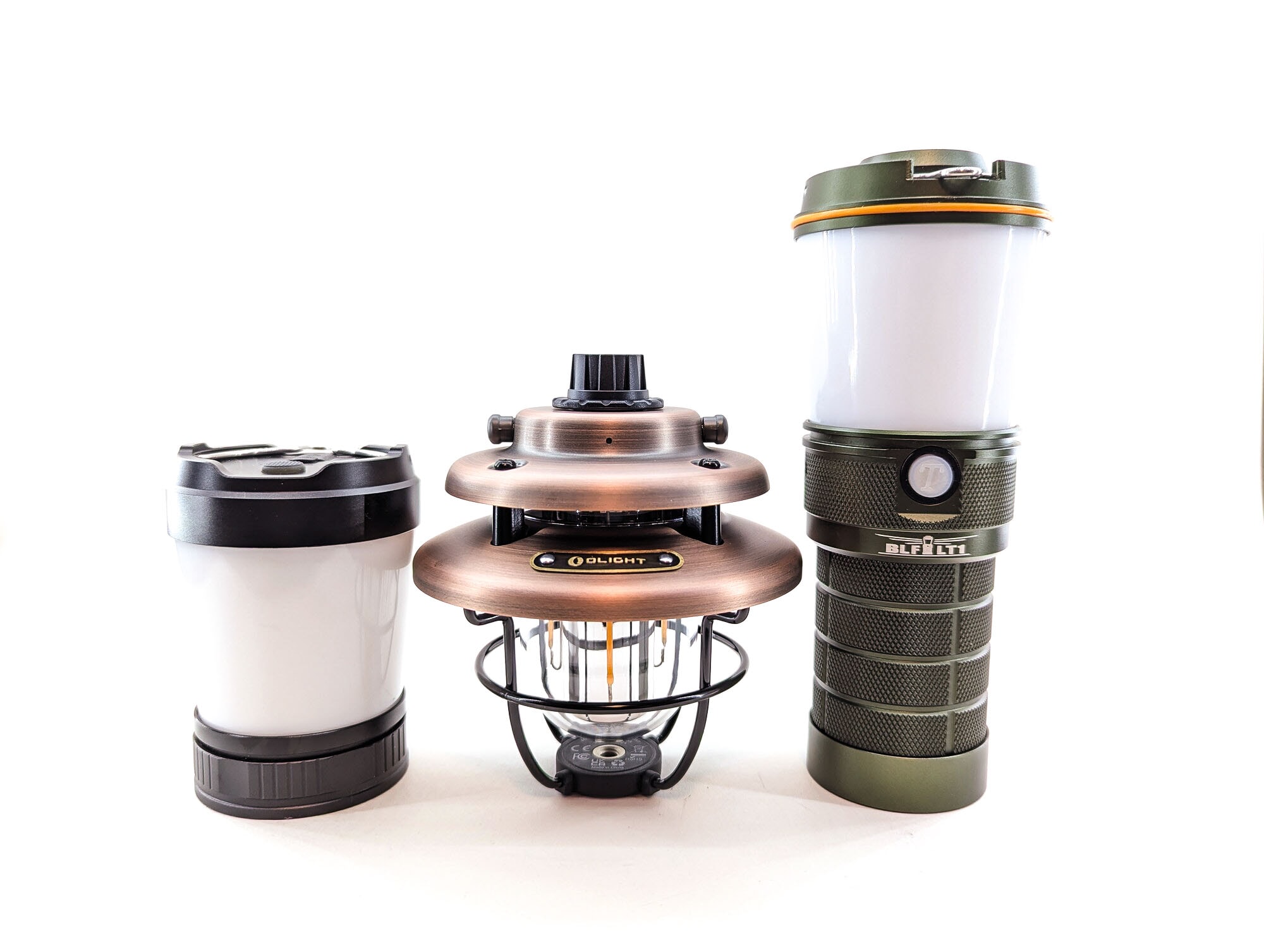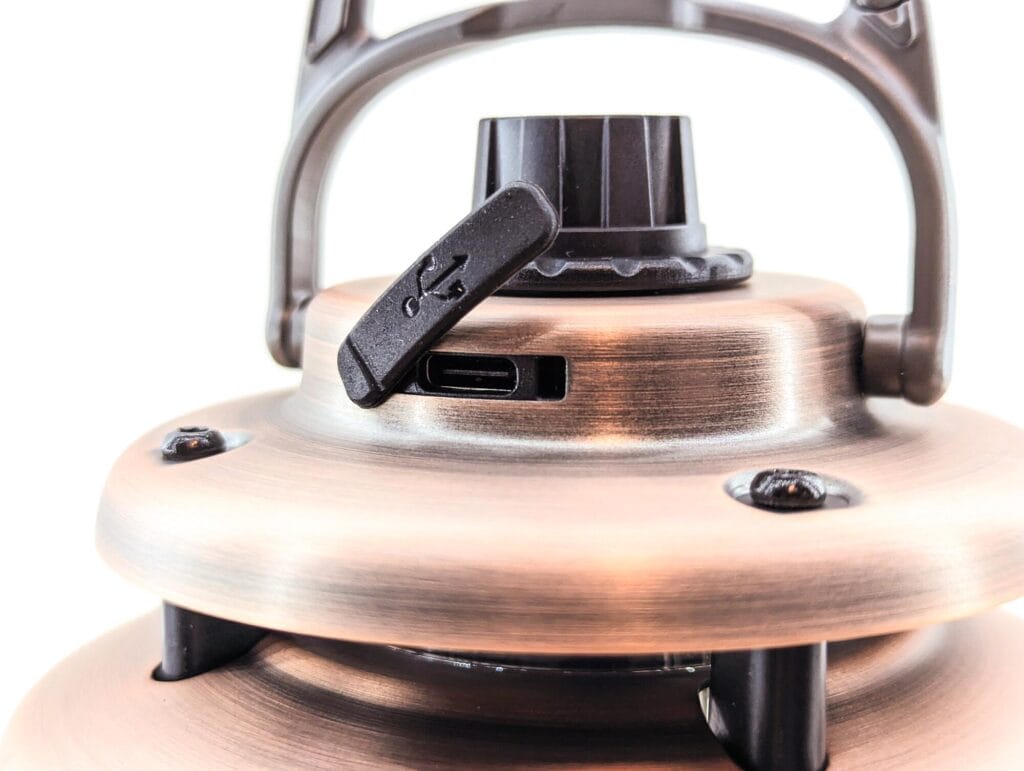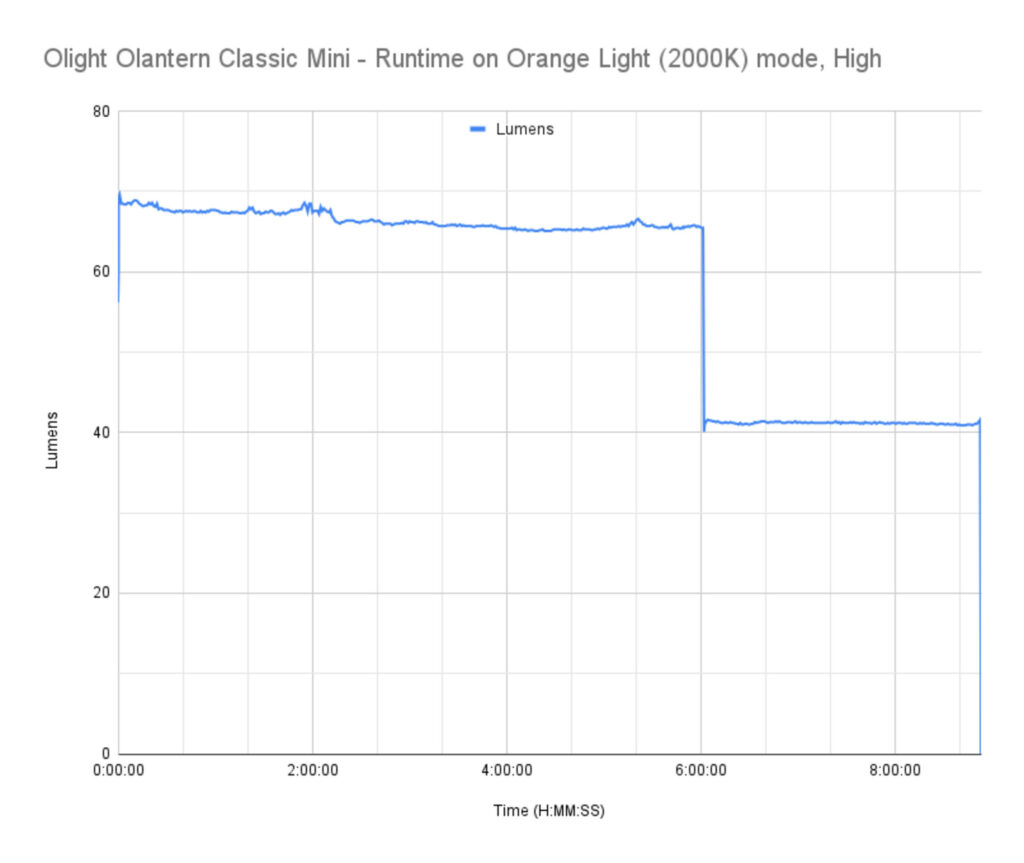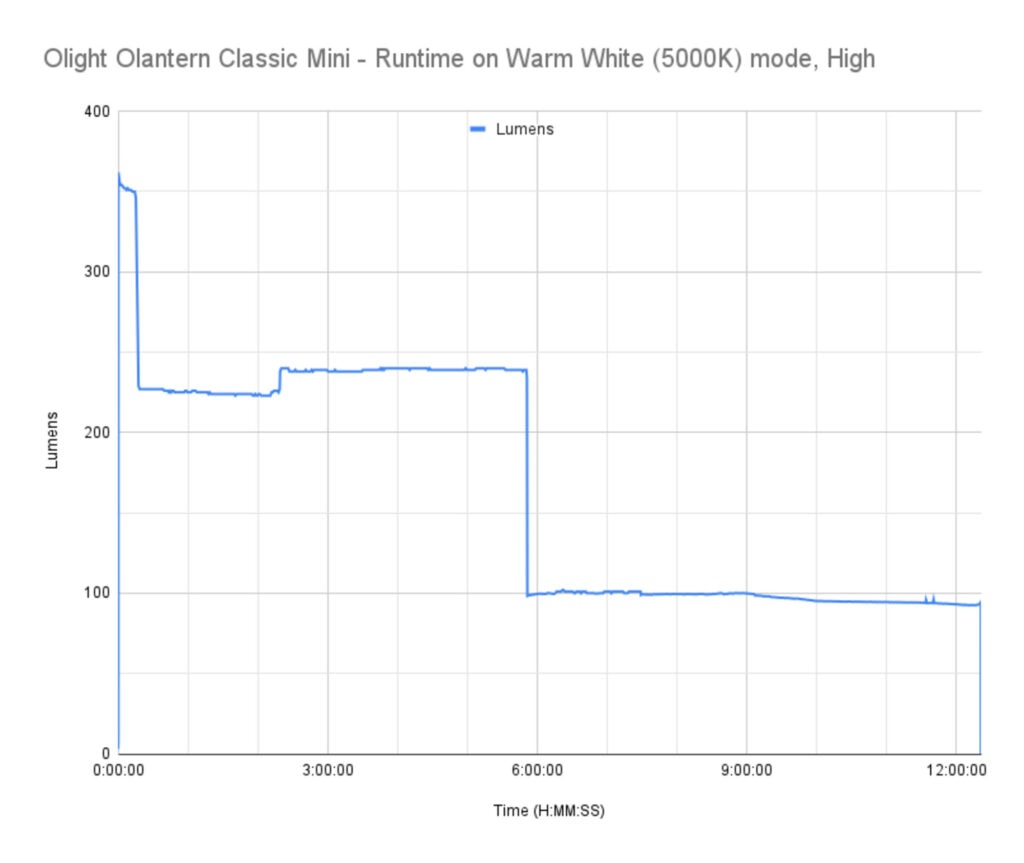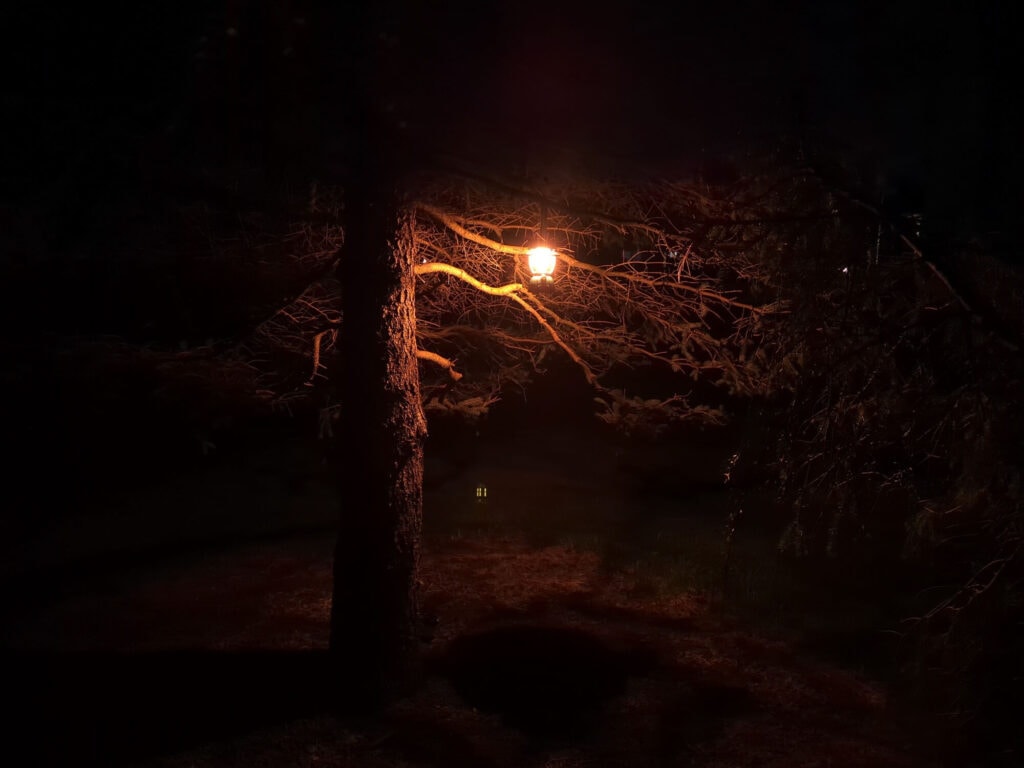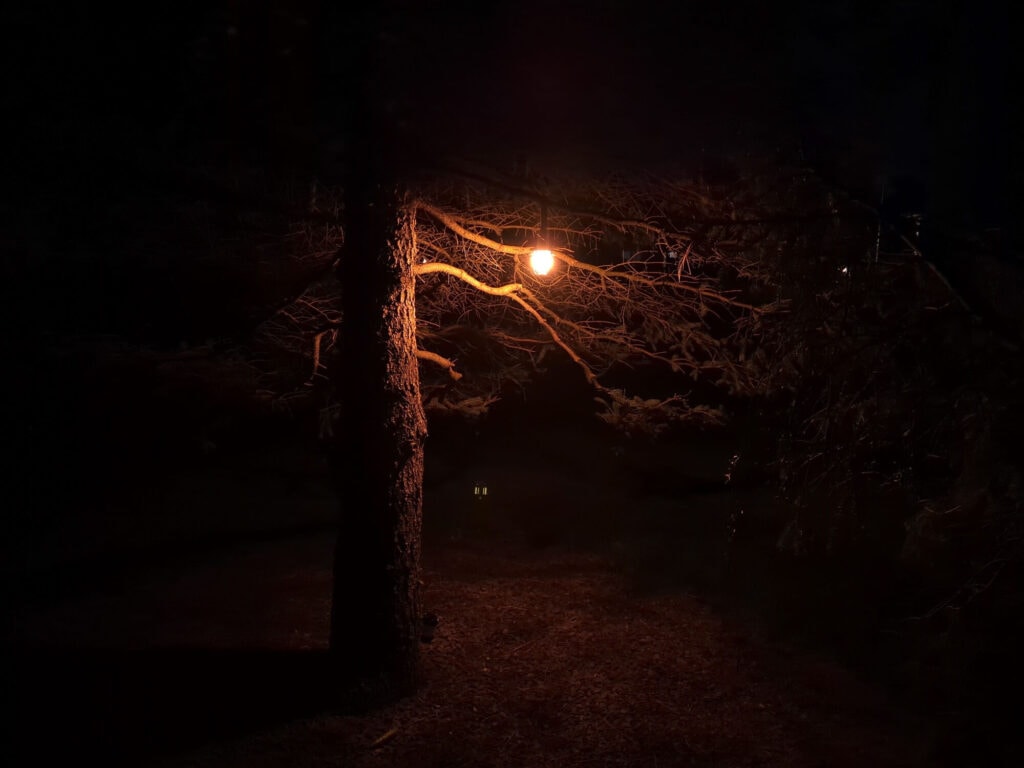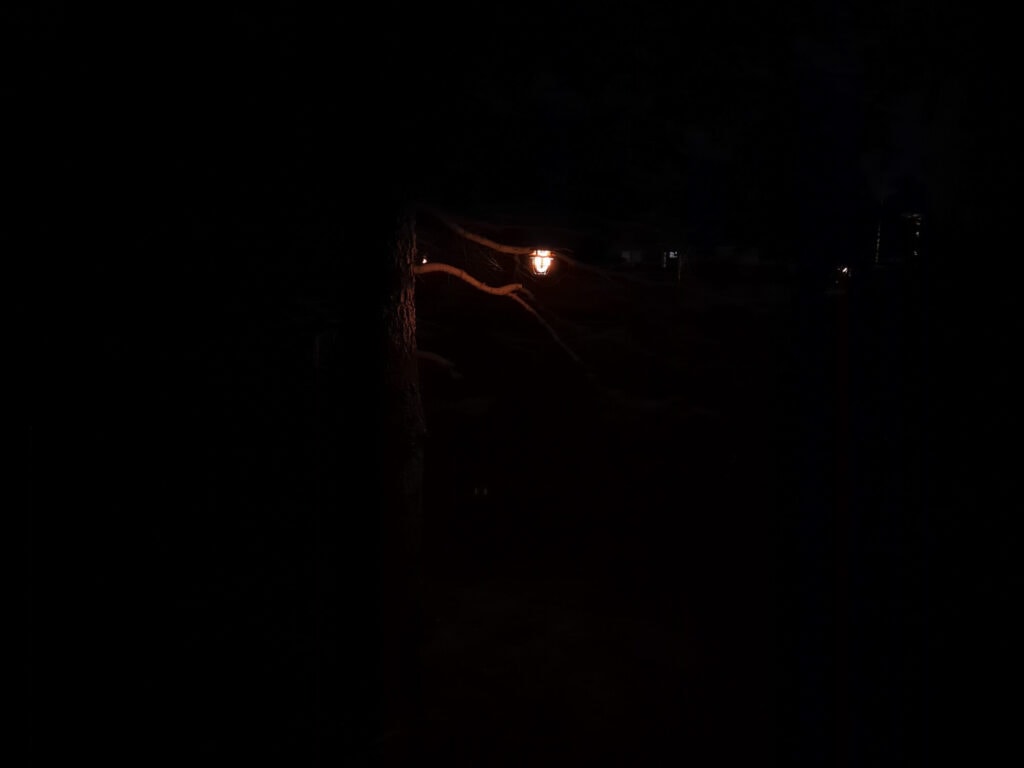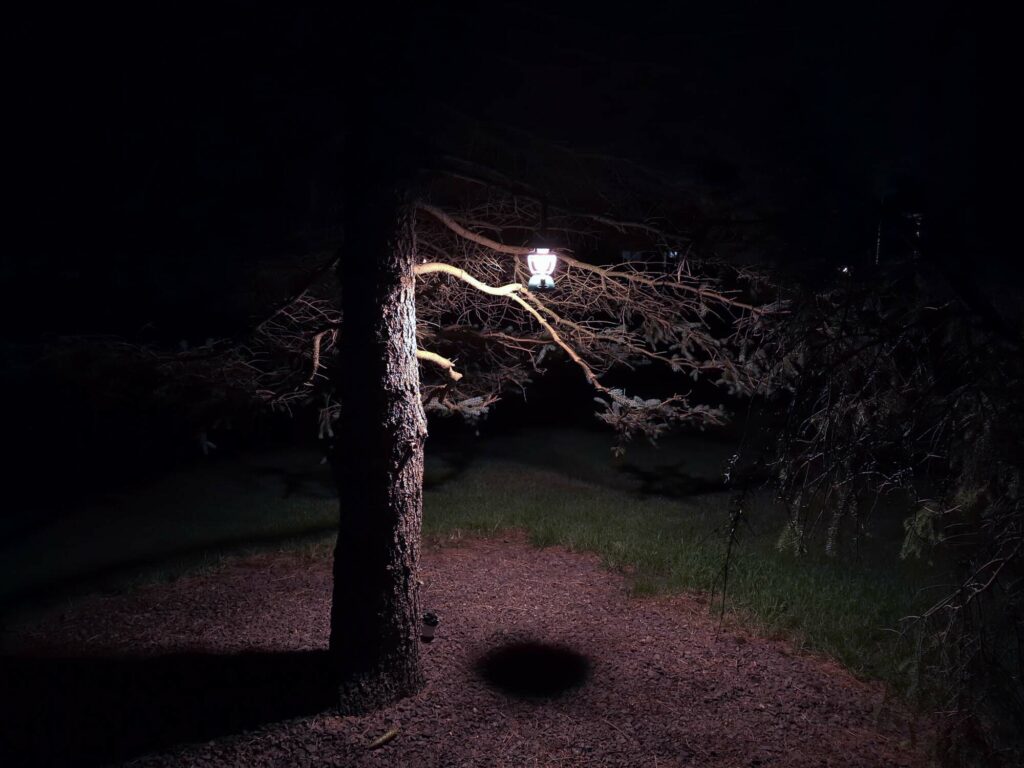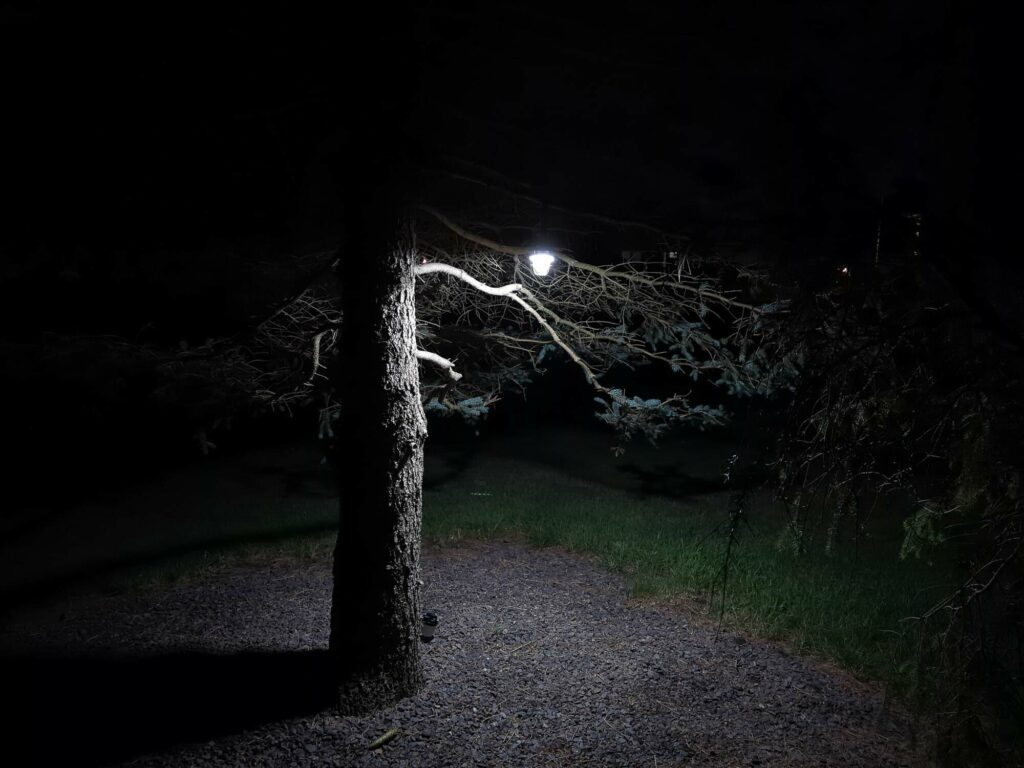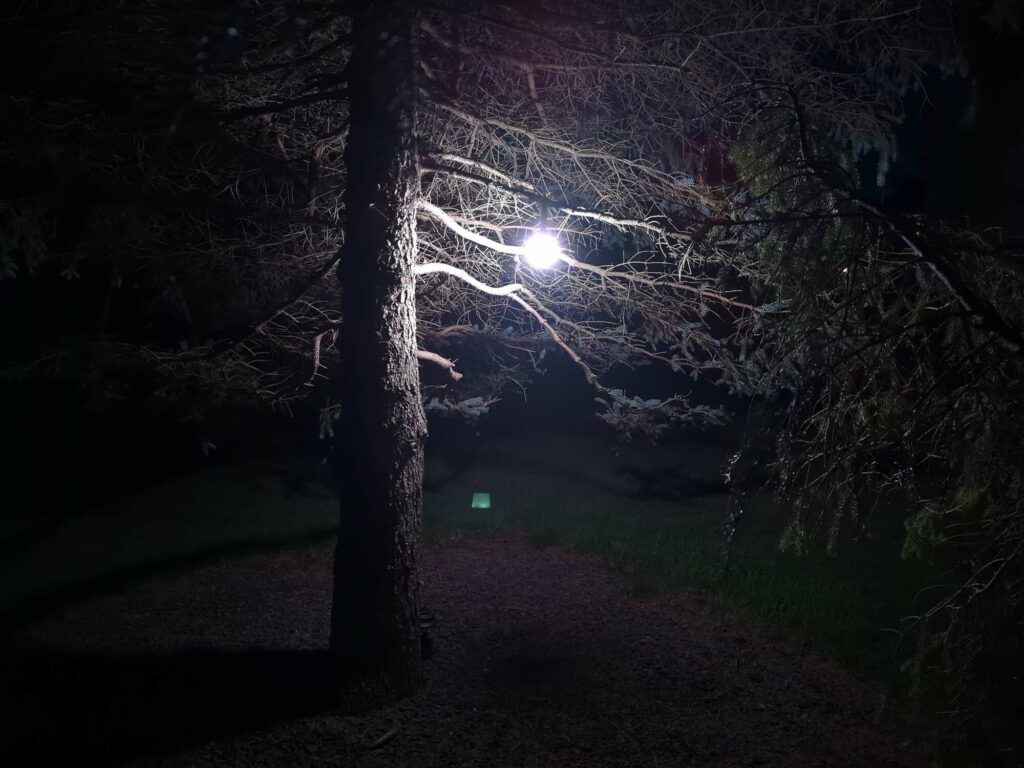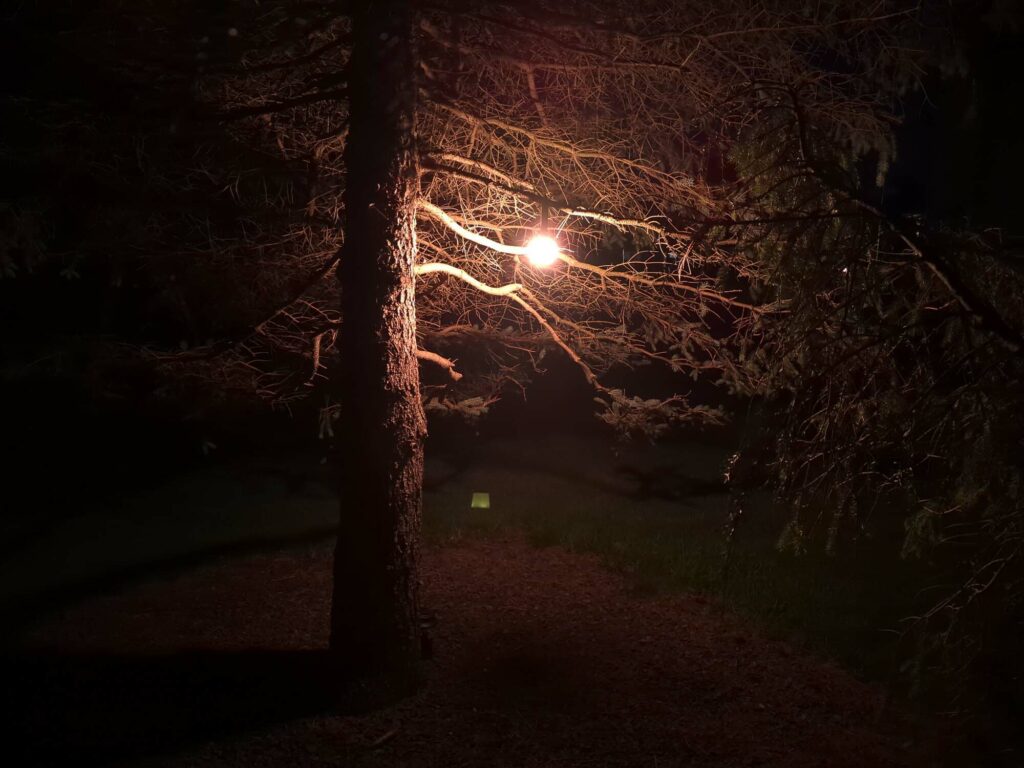1lumen selects and reviews products personally. We may earn affiliate commissions through our links, which help support our testing.
Olight Olantern Classic Mini review
Olight Olantern Classic Mini specs
| Brand & Model | Olight Olantern Classic Mini |
|---|---|
| Flashlight category | lantern |
| LED | Filament LEDs + SMD LEDs |
| Max. output | 300 lumens |
| Max. beam distance | 20 meters |
| Max. beam intensity | 98 cd |
| Battery config. | Built-in |
| Onboard charging | USB-C |
| Main modes | Variable |
| Blinkies | N/A |
| Waterproof | IPX5 |
| Review publication date | July 2023 |
Review intro:
Olight has a pretty broad selection of lights. They make some great keychain lights such as the i3E EOS and the i1R 2 Pro. Olight also has EDC lights like the Baton series. But that’s not all… gun lights, tactical lights, high-power lights, general lamps/lanterns, and now branching out into things like knives and pens. For the most part, if it needs to be lit up, Olight has you covered. One of the things I love most about Olight is their attention to detail. Quality is generally fantastic, anodizing and machining are great… they just know how to make a solid product.
This particular model – the Olight Olantern Classic Mini – brings together two of their existing products. There’s already an Olantern Mini that looks pretty modern and could honestly be mistaken for any other of a number of LED lanterns on the market. And then there’s the Olight Olantern Classic 2 Pro – a more “full size” lantern with beautiful classic styling. I like Nick’s review of the Olantern Classic 2 Pro so much that I went out and bought my own, and I use it daily. The new Olantern Classic Mini draws on the timeless look of its larger brother and nearly all of its functionality, in a more portable form factor.
The Olight Olantern Classic Mini comes ready to go, but in locked mode. To unlock it, quickly twist the knob on-off-on-off. It’ll vibrate to let you know that it has been unlocked (new features compared to the Classic 2 Pro: vibration and a lock-out mode!).
Package quality.
The Olight Olantern Classic Mini came in a nicely designed white box with an image of the lantern on the front along with some key specs. The back contains a little description and additional specs. Open taking off the shrink-wrap plastic and opening the box, you’ll immediately see a brightly colored card to inform you that the light is locked out. You can then slide out some carefully cut cardboard bits that securely hold the lantern and its accessories in place. In total, you’ll find:
- Olight Olantern Classic Mini
- USB-C charging cable
- Instruction manual
Flashlight in use
Upon removing the Olight Olantern Classic Mini from the box, I arrived at two immediate conclusions: just like its big brother, I love the looks of it. The other: it seems geared towards being hung or mounted. The metal bail loop includes a carabiner-like clip that is perfect for hanging inside a tent or from a RV canopy, boat bimini top, small tree branch, hook, or rope.
There’s also a ¼” tripod screw hole in the very bottom center of the unit, giving it additional mounting options. Olight advertises a bundle with the Classic Mini and their Tactical Tripod for table-top use, which is a good idea if you plan to use it in that manner. You absolutely can use it on a table top by itself and it will sit there with decent stability. However, a big enough of a bump will send it rolling away. This is what I consider to be the primary difference between this unit and the Olantern Classic 2 Pro, which has a wide, flat base and low center of gravity. The Olight Olantern Classic Mini not only looks like it’s the better option for hanging, but it’s also 45% lighter. That could be an added bonus when hanging it from a lightweight structure like a tent.
Build Quality and Warranty
Olight is one of the companies that puts a lot of effort in the design and quality of their lights. I have not yet been let down by Olight in the “build quality” department. Just like Nick’s observations about the Olantern Classic 2 Pro, the Classic Mini has top-notch build quality, fit, and finish. The shade and cage are constructed of metal, and the globe is polycarbonate. The rotary dial (the only control) is very smooth and has a strong “click” when transitioning between Off and On. Olight also added a vibration when transitioning between the “warm white” and “orange light” modes. You’ll also notice that when locking/unlocking the lantern.
My review sample came sporting the “vintage copper color” finish, which is very lovely and classy. The Olantern Classic Mini also comes in Forest Green and Black.
The Olight Olantern Classic Mini is IPX5 rated, so you should be good-to-go through a bit of rain and splashing. Olight has given the Classic Mini a 0.8m drop rating.
Warranty:
- Within 30 days of purchase: Contact the original seller for repair or replacement.
- Within 2 years of purchase: Contact Olight for repair or replacement.
LED, Lens, Bezel, Beam, and Reflector
As is typical of Olight, there’s no word on exactly what LEDs are at play here. The LED setup on the Olantern Classic Mini is very reminiscent of the Olantern Classic 2 Pro and the Haloop. There are 3 LED filaments that Olight describes as “orange light” (2000-2100K). Those are supplemented by 4 SMD LEDs on a PCB in the top shade, just above where the polycarbonate globe mounts. There is also a ring of SMD LEDs behind a diffuser that Olight calls “warm white” (5000-5500K). That’s not what I would typically call “warm white”, but this is Olight we’re talking about, so I’ll give them a little bit of slack considering their normal CCT is around 6500. The single control knob allows you to steplessly ramp the brightness of the warm LED filaments before those give way to the neutral LEDs which also ramp smoothly.
The two CCT ranges give you a lot of flexibility and help cover different use cases. Sitting around a campfire? Winding down in your tent? Snuggled up in bed with your favorite novel? Dial the Olantern Classic Mini to it’s orange light range and kick back. Alternatively, if you’re using it for task lighting or need to illuminate something more clearly, dial it up to the warm white range.
One thing that’s different between this model and the Classic 2 Pro: you’ll notice a shiny cylindrical reflector in between the LED filaments. That reflector looks to be just larger than a 21700 battery, so I have a pretty good idea where the juice is being stored (though Olight hasn’t said anything about what cell(s) are inside).
White Light, High:
- CCT: 5082K
- CRI: 83.8 Ra
- DUV: +0.0018
Orange Light, High:
- CCT: 1875K
- CRI: 89.3 Ra
- DUV: +0.0047
Dimensions and its competition
Dimensions:
| Millimeters | Inches | |
|---|---|---|
| Height | 110 mm | 4.3 in |
| Diameter | 124 mm | 4.9 in |
Dimensions are rounded to the nearest millimeter, and to the nearest tenth of an Inch.
Weight:
| Weight in grams | Weight in oz | |
|---|---|---|
| With battery | 415 g | 14.6 oz |
Weight is rounded to the nearest gram, and to the nearest tenth of an Oz.
Flashlight size comparison with its competition:
Group 1: Olight Olantern Classic 2 Pro, Olight Olantern Classic Mini
Group 2: Sofirn LT1S Pro, Olight Olantern Classic Mini, Sofirn BLF LT1
Olight Olantern Classic Mini UI: User Interface and Driver
There’s no mention of the driver, so I can’t say for sure what’s under the hood, but if I could venture an opinion, it’s probably a constant-current buck driver since the battery output is 4.2 volts.
The UI is as simple as it gets. No modes, no clicking, nada. Turn the knob clockwise to make it brighter or counterclockwise to make it dimmer.
Available modes:
- Infinitely variable brightness with dual tint: Orange Light and White Light
Available blinky modes:
- none
From OFF:
- Turn the rotary switch clockwise: Turns on in Orange light Low mode
From ON:
- Turn the rotary switch clockwise: Increases brightness from low to high in Orange Light mode
- Turning the rotary switch further transitions to the White Light Low mode. Continuing to turn the switch will stop at White Light High mode
- Turn the rotary switch counterclockwise: Decreases brightness
- Turn the rotary switch fully counterclockwise: Turns off
Mode memory:
- N/A
Shortcuts:
- N/A
Low voltage warning/protection:
- There is a battery level indicator LED between the rotary knob and the Olight nameplate
- When rotating the knob, the indicator turns on for 5 seconds
- Green light: 30%-100%
- Red light: 5%-30%
- Red light flash: 0%-5%
Strobe/blinkies
- N/A
Lock-out mode:
- Unlike it’s big brother, the Olight Olantern Classic Mini does include a lockout mode
- Twist the knob on-off-on-off to lock out the lantern. It will do a long vibrate to confirm.
- Repeat the same action to unlock the lantern. Again, it will vibrate to confirm.
PWM
- There is no PWM
Additional/summary info on the UI:
- The UI is as simple as can be, and that’s a great thing. I could hand this to my 4 year old and he’d have no problem operating it.
Olight Olantern Classic Mini Charging and batteries
The Olight Olantern Classic Mini has a battery. Olight doesn’t exactly say what’s inside, but they do mention it’s a rechargeable li-ion battery with 16.65 Wh (4500 mAh / 3.7V) capacity. That sounds a lot like a 21700 cell if you ask me. And there’s just the right amount of space inside that reflector for it.
Charging is taken care of via the USB-C port behind a dust plug on the back of the top shade. Olight says the charging is best done with a 10W or higher power source and that it should take no more than 5 hours to fully charge the light. When hooked up to my 33W USB-PD adapter, I saw a charge rate of 11.1 watts (2.20 amps at 5.04 volts). My USB tester says that charging stopped at 3 hours and 4 minutes, transferring 21.1 Wh / 4173 mAh.
The manual doesn’t really say much about being able to use the Olight Olantern Classic Mini as a power bank. The only mention I can see is it calls out battery indicator LED colors for “when discharging”. That’s the only language around it. But sure enough, I plugged my phone into it with a USB-C to USB-C cable and the Olantern Classic Mini started charging my phone! I couldn’t measure the charging current, but my phone did say “charging rapidly” which is a good sign.
Performance test
Lumen measurements
How Lumens are Measured: Understanding ANSI FL1 Standards How Lumens are Measured: Understanding ANSI FL1 Standards: The ANSI FL1 standards specify that output in lumens should be measured 30 seconds after turning on, as this is the standardized time for measuring brightness according to the industry standard. This is why we focus on this part in our measurements. The ANSI FL1 standards require an ambient temperature of 22 ± 3°C. We record the ambient the ambient temperature to identify potential reasons for any observed discrepancies.Lux was measured by a UNI-T UT383 BT at 1 meter. Lumens were measured using a VEML7700 sensor, calibrated with a calibration light provided by 1Lumen. With this being a lantern, I couldn’t rely on my lumen tube, and instead, used a large white “integrating storage bin”. Due to the design of the battery, current tests were not possible
| Mode | Specs | turn on | 30 sec | 10 minutes |
|---|---|---|---|---|
| Low, Orange | 5 | 7 | 7 | – |
| High, Orange | 100 | 70 | 70 | 69 |
| Low, White | 130 | 158 | 158 | – |
| High, White | 300 | 362 | 359 | 351 |
Parasitic drain:
- N/A – couldn’t measure due to internal battery design
My measurement for the Warm White (~5000K) mode was actually above the Olight specs, but the Orange Light (~2000K) came in quite a bit short. I generally feel very confident in my readings, but there can be a lot of variables when trying to measure the output of a lantern. So while the Orange Light mode is likely lower than spec, some of that could be limitations of the measurement environment.
Olight Olantern Classic Mini Battery Life: Runtime graphs
How Runtimes are Measured: Understanding ANSI FL1 Standards About ANSI FL1 runtime standards: The runtime is measured until the light drops to 10% of its initial output (30 seconds after turning on). This does not mean that the flashlight is not usable anymore. The last column shows how long the light actually works till it shuts off. If there is a + symbol, it means that the test was stopped at that particular point, but the light was actually still running. This happens on certain occasions, with certain drivers, firmware, or batteries.| Mode | Specified runtime | Measured runtime ANSI | Time till shut off |
|---|---|---|---|
| Low, Orange | 60h | ||
| High, Orange | 8h | 8h 53min | 8h 53min |
| Low, White | 12h | ||
| High, White | 9h 18min | 12h 20min | 12h 20min |
The runtimes were very favorable. I tested both High modes and got longer-than-spec runtimes. With those kinds of numbers, there’s no need to worry about your lantern lasting all evening long when camping, or even a couple evenings at 4-6 hours each.
Peak beam intensity and beam distance measurements
About Peak beam intensity: Understanding ANSI FL1 Standards About peak beam intensity The calculated value of distance in meters at which the flashlight produces a light intensity of 0.25 lux. (0.25 lux is about the brightness of a full moon shining on an object). This means that the intensity has decreased so much, it becomes difficult to see darker objects, or objects that don’t reflect light. The columns ‘Meters’ and ‘Yards’ use rounded numbers.| Mode | Specs | Candela measured | Meters | Yards |
|---|---|---|---|---|
| Low, Orange | (2m) | – | – | – |
| High, Orange | (11m) | 12 cd | 7m | 8 yd |
| Low, White | (13m) | – | – | – |
| High, White | 98 cd | 40 cd | 13m | 14 yd |
For beam intensity, I did measure a bit less than Olight’s spec. The light could actually be lower than spec, but I also don’t typically measure intensities this low. It could be that my lux meter isn’t as sensitive in this low of a range. Either way, you generally want a lantern to have well diffused light, so I almost consider lower intensity readings to be a good thing.
Beamshots
Camera settings and distance:
These lanterns are hanging in a pine tree approximately 3 meters away. The shots were taken with a Pixel 7 set to ISO 852 with 1/12 second exposure time
Beamshots of the following flashlights compared:
- Olight Olantern Classic Mini (warm white and orange light)
- Olight Olantern Classic 2 Pro (warm white and orange light)
- Sofirn LT1S Pro (cool and warm light)
Disclaimer: This flashlight was sent to me for review at no cost by Olight. I have not been paid to review, nor have I been holding back on problems or defects.
Final Verdict
Pros
- Beautiful, classy design
- Several mounting/usage options
- Great fit and finish
- Stable, regulated output
- Super simple UI (rotary knob)
- Dual-tint output
- USB-C charging
- Power bank feature
- Smaller, more portable size than Classic 2 Pro
Cons
- Top-heavy, tripod recommended for table-top use
Explanation on star ratings:
1: Avoid: a match would be a better choice – 2: Poor: significant defect or issues; almost unusable – 3: Average: some defects or issues; but still usable 4: Good: recommended (minor issues) – 5: Great: highly recommended
5 stars: ★★★★★
While our star rating provides a reliable indicator, we encourage you to read the full review to make an informed decision based on your own needs and preferences.
I love a good lantern. I end up using them even more than flashlights because they can be so handy around the house for cordless ambient lighting in addition to the obvious uses like out on the patio, at a campsite, in your tent, or for emergency lighting during power outages. After reading Nick’s review on the Olight Olantern Classic 2 Pro, I went out and bought my own and I now use it every day. I love its styling, functionality, and long-lasting power.
When I saw the Olantern Classic Mini, I knew it would be an instant hit as well. It has pretty much everything that its bigger brother does, but is smaller and lighter, so it’s definitely more portable. Being more top-heavy and with a smaller base, the design lends itself much more to hanging or tripod use.
If you’re trying to decide between the two, I’d say if you’re going to primarily use it on a table, grab the Classic 2 Pro. However, if you want additional portability and will be hanging it, the new Olantern Classic Mini is an excellent choice.
Buy your Olight Olantern Classic Mini with a discount
Use our exclusive 1lumen discount code to get an extra 10% off anything you order at Olightstore.com (USA). Coupon code: 1lumen
1lumen selects and reviews products personally. We may earn affiliate commissions through our links, which help support our testing.
